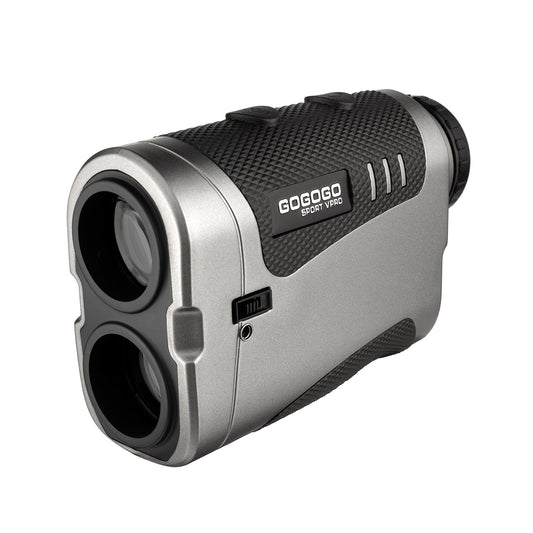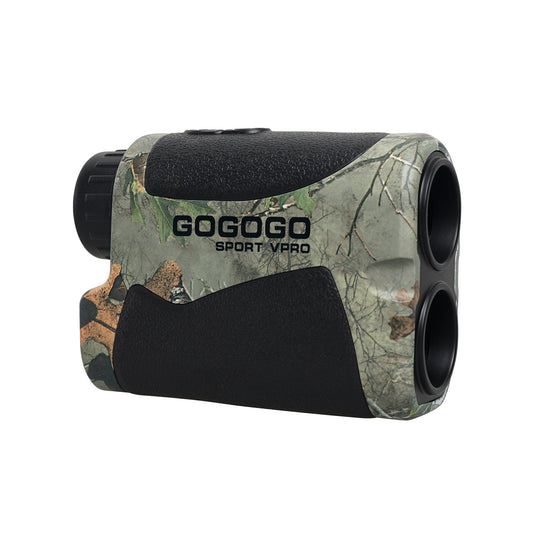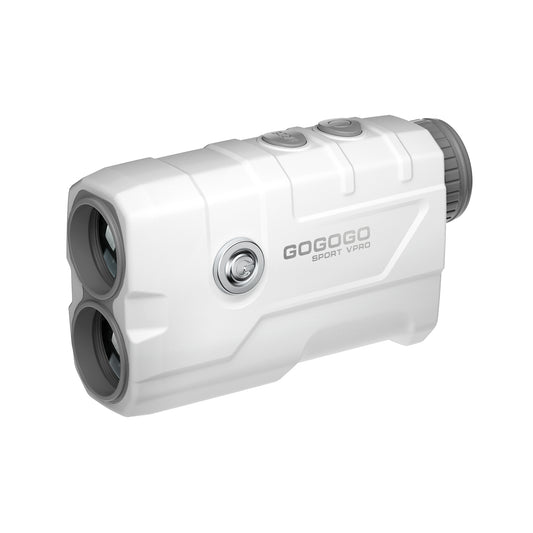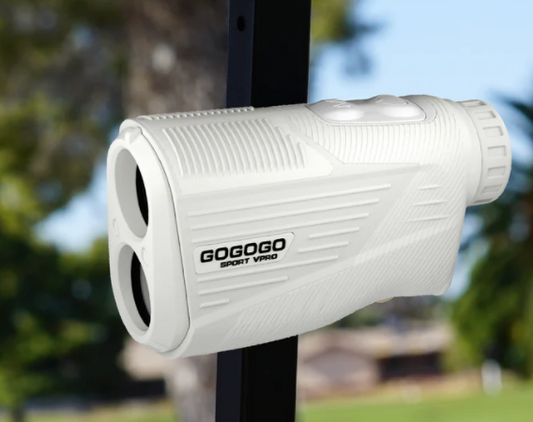Rangefinders are indispensable tools for those who hunt, golf or engage in other activities requiring precise distance measurement. However, not all rangefinders are created equal. Some offer angle compensation, which can make a significant difference in accuracy, especially on sloped terrain. In this article, we’ll explore what angle compensation is, why it’s essential, and how to use it effectively.

How Does a Rangefinder Work?
Rangefinders operate based on laser technology that calculates the distance by measuring the time it takes for a laser beam to travel from the device to the target and back. When you aim the rangefinder at a target and press the measurement button, it emits a laser beam. The time it takes for the beam to reach the target and reflect back to the device allows it to calculate the distance.
Here’s how it works in a nutshell:
- Laser Emission:The rangefinder emits a laser beam toward the target.
- Reflection: The laser beam hits the target and reflects back to the rangefinder.
- Time Calculation: The rangefinder calculates the time taken for the beam to make the round trip.
- Distance Measurement: Using the speed of light, the device computes the distance to the target.
Many rangefinders now also come with features like angle compensation, which further enhances the accuracy of distance measurement by factoring in angles between the rangefinder and the target.
What is Angle Compensation in a Rangefinder?
Angle compensation is a feature that adjusts a rangefinder’s distance measurement to account for the incline or decline of a shot. Standard rangefinders typically provide a line-of-sight distance, which may work well on flat ground but can lead to errors on hilly or sloped terrain. When aiming up or down, the actual travel distance (the horizontal distance that would affect a projectile’s trajectory) is shorter than the line-of-sight distance.
For example, let’s say you’re aiming at a target on a hill from a lower vantage point. Without angle compensation, your rangefinder may measure the straight-line distance but not consider the effect of the upward angle. Angle compensation ensures that the distance shown is more accurate for such angled shots.
Angle compensation uses trigonometric calculations to adjust the reading, considering the line-of-sight distance and the angle to deliver an accurate measurement of the horizontal distance. This adjustment is critical for activities like hunting, archery, and golfing, where accurate shot placement is crucial.
Why is Angle Compensation Important?
In activities where precision is critical, angle compensation is essential for accurate measurements. Here’s why:
- Hunting and Archery: Animals are often positioned at different elevations, either uphill or downhill from the hunter. Without angle compensation, the line-of-sight distance provided by a standard rangefinder could result in an inaccurate shot. Angle compensation corrects the distance for the angle, giving hunters a reliable reading for more precise shooting.
- Golfing: Golf courses are rarely flat, and golfers frequently need to assess distances on slopes. When hitting uphill or downhill shots, relying on line-of-sight distance alone can lead to poor club selection and missed shots. A rangefinder with angle compensation can give golfers an adjusted reading that factors in the terrain, allowing for more informed club choices.
- Surveying and Other Outdoor Activities:In surveying or outdoor navigation, angle compensation is often necessary to obtain accurate measurements on uneven landscapes.
Without angle compensation, users risk making decisions based on inaccurate distances, which can affect everything from shot accuracy to overall performance.

How to Use a Rangefinder with Angle Compensation?
- Enable Angle Compensation: Some rangefinders have dedicated modes or settings for angle compensation, so make sure it’s activated. Check the user manual if you’re unsure how to turn it on.
- Choose the Correct Mode: Rangefinders often have different modes tailored to specific activities. For instance, some rangefinders have modes for golf, hunting, or general measurements. Selecting the correct mode can optimize the rangefinder’s angle compensation settings.
- Aim at the Target:Hold the rangefinder steady, aim it at the target, and make sure it’s locked onto the object you’re measuring. Many rangefinders have built-in stabilization features to help with this.
- Take the Measurement:Press the measurement button to get the reading. The rangefinder will display the angle-compensated distance, which is typically labeled as the “true horizontal distance” or “adjusted distance.”
- Interpret the Reading:The rangefinder will often show both the line-of-sight distance and the adjusted distance. Use the adjusted distance for your shot or measurement, as it accounts for the slope and provides a more accurate measurement.
What Factors Affect Rangefinder Accuracy with Angle Compensation?
Several factors can influence the accuracy of a rangefinder with angle compensation, including:
- Environmental Factors
- Weather Conditions: Fog, rain, and snow can interfere with the laser signal, leading to inaccuracies.
- Lighting Conditions: Extremely bright or low-light conditions can also impact the performance of a rangefinder.
- Device Factors
- Range and Magnification: Rangefinders vary in maximum distance and magnification levels, which can affect precision. Higher-quality devices tend to offer more reliable angle compensation and are more effective at greater distances.
- Battery Life: Consistent battery power ensures accurate readings. A low battery can lead to inaccuracies or failure in displaying readings.
- User Technique
- Holding Steadiness: If the rangefinder is held unsteadily, the laser may not hit the exact target, leading to unreliable measurements.
- Target Lock:Make sure you are correctly aiming at the intended target. Advanced rangefinders come with “target lock” or “pin-seeking” features to ensure accuracy.
Each of these factors can play a role in the effectiveness of a rangefinder, so it’s wise to choose a model with solid build quality and user-friendly features that minimize these challenges.
Where to Find a Value-for-Money Rangefinder with Angle Compensation
Finding a quality rangefinder with angle compensation at a reasonable price involves some research. Here are some good options:
- Online Retailers:Amazon, Walmart, and sporting goods retailers like Dick’s Sporting Goods often carry a variety of rangefinders at competitive prices. These platforms also feature user reviews, which can be helpful in making a decision.
- Golf and Hunting Specialty Stores: These stores usually carry more specialized models and offer guidance on choosing the best rangefinder for your needs.
- Manufacturer Websites: Brands like Bushnell, Vortex, andGoGoGo Sport Vpro often sell directly from their websites, where you can find detailed product information and sometimes discounts.
When shopping, consider features like angle compensation, range, and ease of use, and always compare models within your budget to find the best deal.
GoGoGo Sport VPro GS24 PRO - You Deserve it
For a rangefinder that offers excellent value without sacrificing quality, the GoGoGo Sport VPro GS24 PRO is a top choice. This model is popular among golfers and hunters alike for its combination of affordability and advanced features.
Key Features:
- Angle Compensation: The GS24 PRO comes with built-in angle compensation, making it ideal for use on uneven terrain. The angle-compensated distance feature ensures accurate readings even on sloped courses or hilly hunting grounds.
- Pin-Seeking and Vibration Technology:For golfers, the GS24 PRO’s pin-seeking technology locks onto the flagstick and vibrates, confirming an accurate reading. This feature is also beneficial in hunting, where steady aim on the target is crucial.
- High Range and Magnification: With a range of up to 650 yards and 6x magnification, it provides ample distance for most golfing and hunting applications.
- Affordable Price Point:At a competitive price, this model offers the necessary features for angle compensation without the high cost associated with some premium models.
Overall, the GoGoGo Sport VPro GS24 PRO is ideal for users who want a dependable rangefinder with angle compensation without breaking the bank. It’s a versatile choice for both golf and hunting, providing accurate distance measurement with intuitive features.








![[2025] The Ultimate Guide to Pinseeker Rangefinders for Golfers](http://gogogosport.com/cdn/shop/articles/gogogo_sport_vpro_pinseeker_rangefinder.png?v=1757993796&width=533)